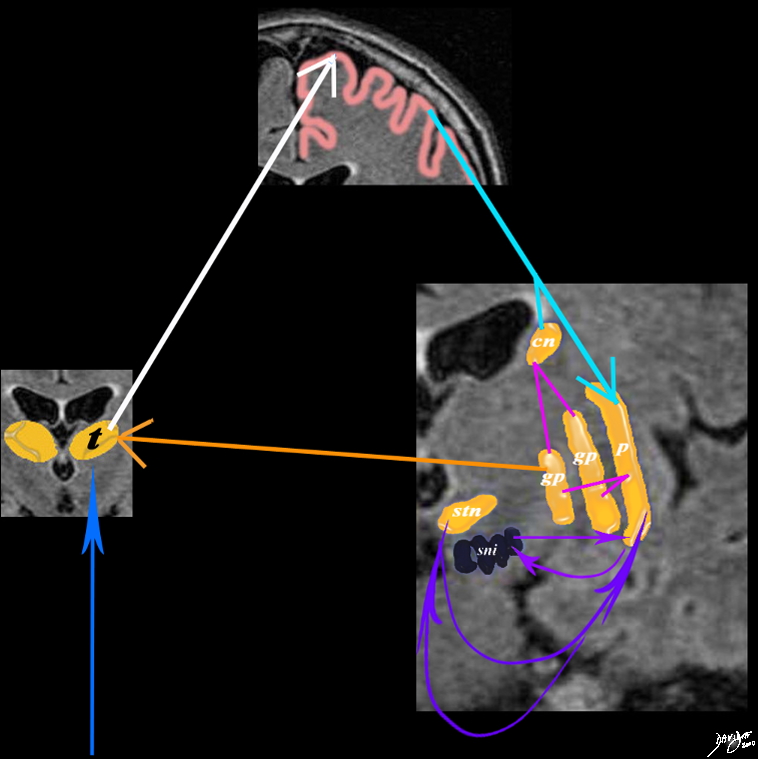The Common Vein Copyright 2010
Definition
The putamen, like the putamen of a fruit, (inner seed) lies in or near the middle of the brain. Together with the caudate nucleus it forms the dorsal striatum. It is involved in learning, particularly when reinforcement of some kind is involved. Disease results in personality changes and the putamen is affected in Huntington’s disease.
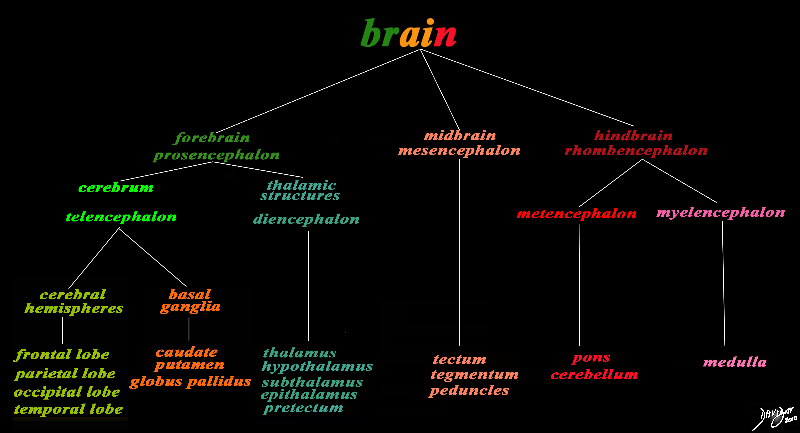 The Putamen (deep orange) The Putamen (deep orange)
Part of the prosencephalon Member of the Cerebrum (Telencephalon) Member of the Basal Ganglia Family |
|
The basic and simplest classification of the brain into forebrain midbrain and hindbrain is shown in this diagram and advanced to a more complex tree using the embryological and evolutionary terminologies. The forebrain consists of the cerebrum also called the prosencephalon, which contains the more advanced form of the brain and the thalamic structures which contain more basic structures. The cerebrum (telencephalon) itself consists of two cerebral hemispheres and paired basal ganglial structures. Each cerebral hemisphere will have gray and white matter distributed in the frontal parietal temporal and occipital lobe, with the basal ganglia being part of the gray matter deep in the cerebral hemispheres. The most important thalamic structures arising from the diencephalons include the thalamus itself and the hypothalamus. The midbrain (mesencepaholon) consists of the tectum tegmentum and cerebral peduncles. The hindbrain has two major branch points based on the evolutionary development. The pons and cerebellum(part of the metencephalon) are grouped and the medulla (part of the myelencephalon is the second branch. Courtesy Ashley Davidoff MD Copyright 2010 All rights reserved 97686.8s |
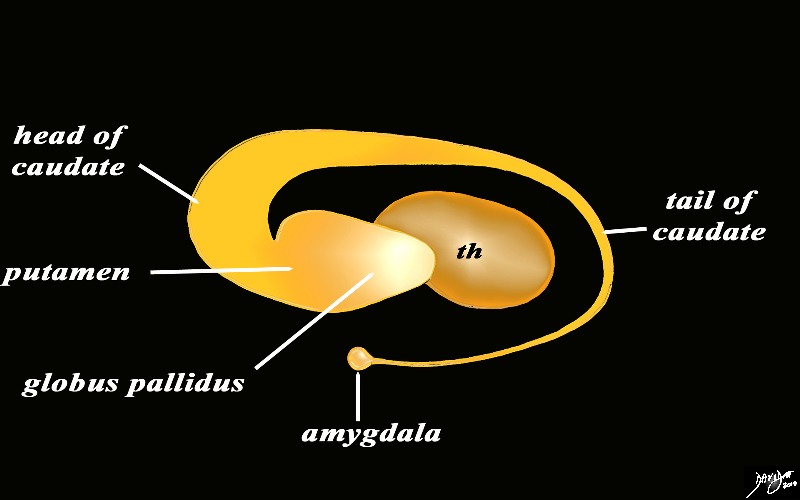 Putamen with Other Basal Ganglia Putamen with Other Basal Ganglia |
|
The basal ganglia lie both in the forebrain and in the midbrain. In the forebrain they are distributed in paraventricular fashion almost in an inverted C fashion. In the conceptual diagrams we have colored the inverted “C” that abuts the ventricular system orange, and this includes the thalamus and the basal ganglia. The basal ganglia that lie in the forebrain include the globus pallidus, putamen, head of the caudate nucleus, tail of the caudate nucleus and the amygdala. The amygdala appears to be part of the limbic system and the basal ganglia. Courtesy Ashley Davidoff MD Copyright 2010 All rights reserved 93907d13b05dL3.8s |
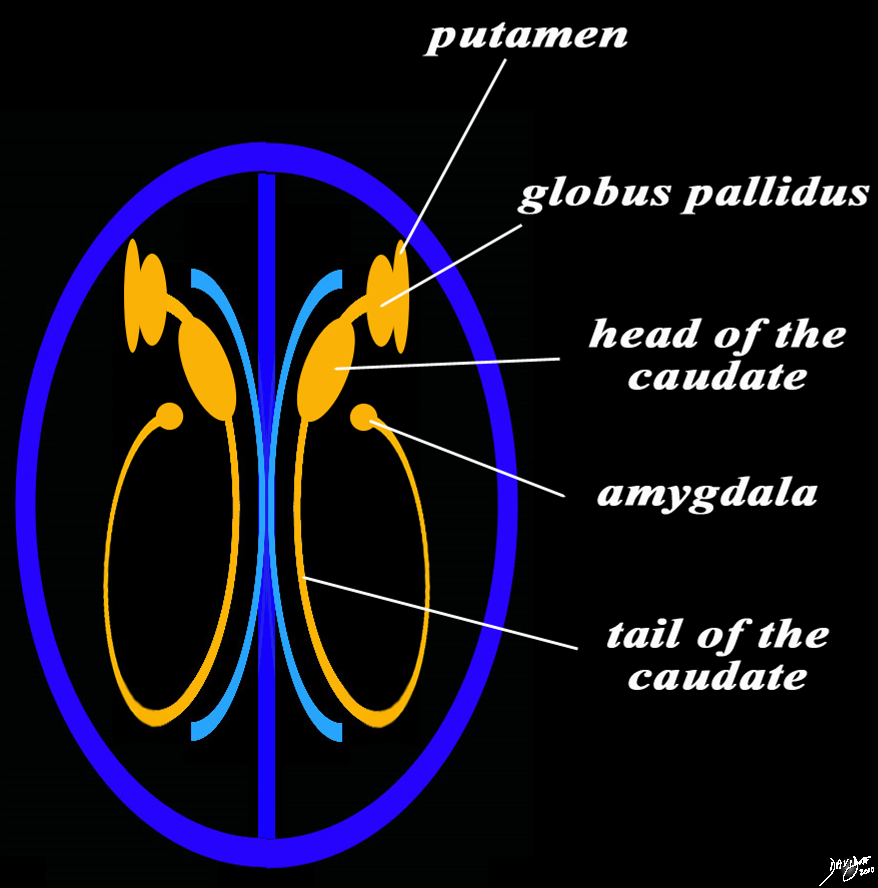 The Putamen in the Context of the Other Basal Ganglia The Putamen in the Context of the Other Basal Ganglia
Axial Projection |
|
The basal ganglia in the forebrain in the axial projection are seen as a continuous inverted C as well. In this diagram their relationship to the ventricles distributed in paraventricular fashion is exemplified. In the conceptual diagrams we have colored the inverted “C” that abuts the ventricular system orange, and this includes the putamen, globus pallidus, head of the caudate nucleus, tail of the caudate nucleus and the amygdala. The amygdala appears to be part of the limbic system and the basal ganglia. Courtesy Ashley Davidoff MD Copyright 2010 All rights reserved 93914.3ka04b01e05.8s |
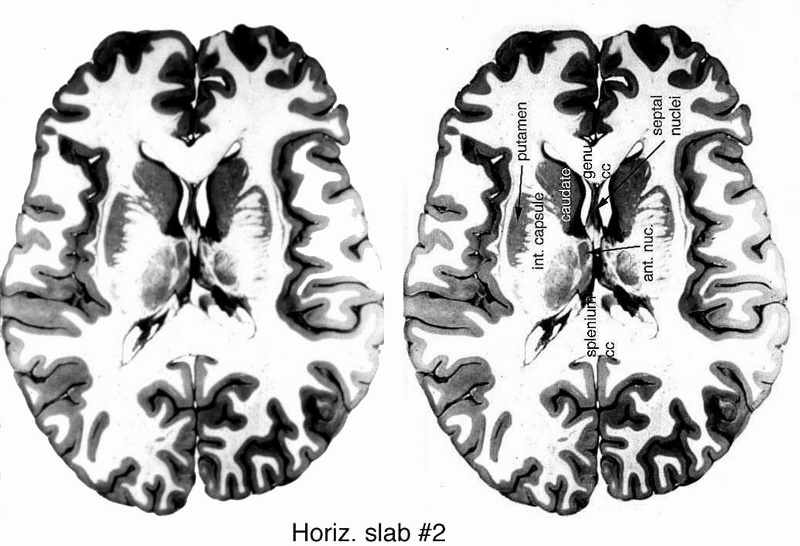
The Putamen in Transverse Section Anatomic Specimen |
|
The anatomic section is an axial slice through the brain showing the ventricles in midline followed by the genu of the corpus callosum anteriorly and splenium posteriorly, the caudate nucleus, the anterior nucleus, putamen and then surrounded by white matter followed by the gray matter Courtesy Courtesy Department of Anatomy and Neurobiology at Boston University School of Medicine Dr. Jennifer Luebke, and Dr. Douglas Rosene 97135c.8 |
 Putamen in Cross Section (Pink Orange) Putamen in Cross Section (Pink Orange)
T2 Weighted MRI |
|
The axial T2 weighted MRI is taken through the level of the ventricles. It demonstrates the midline ventricuar system, the and the orange ring of paraventricuar basal gaglia including tye caudate nuclii (most anterior and medial) the and the putaen. It also demonstrates putamen which is a pink slmomn in color lying lateral to the white matter. The thalami ar noted posteriorly. The body of the corpus callosum is Courtesy Ashley Davidoff MD copyright 2010 all rights reserved 94079cd07b.81sh |
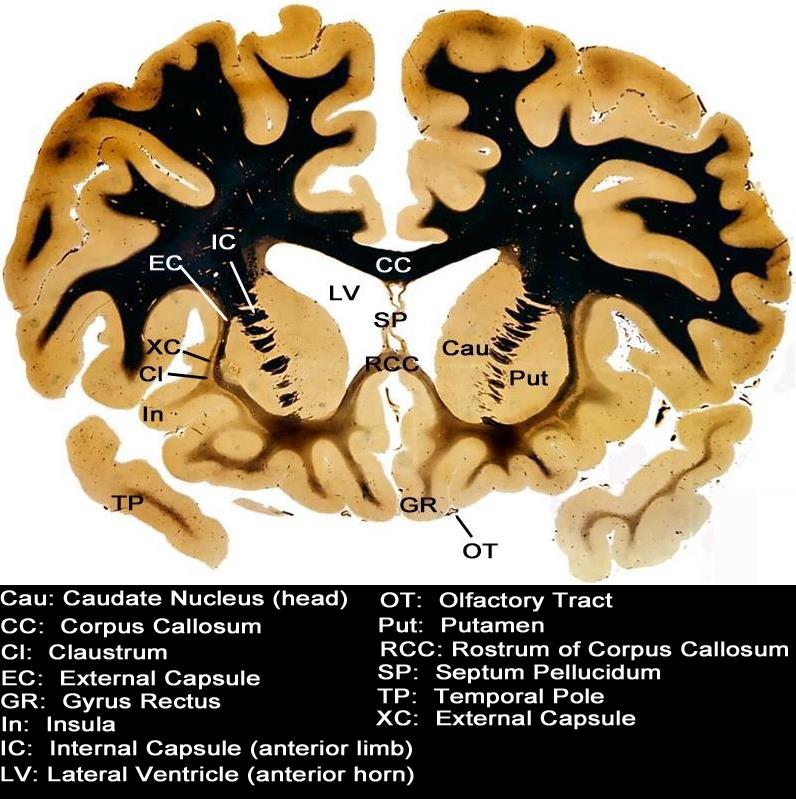 Coronal Section Coronal Section |
|
This coronal section through the forebrain reveals the more superficial cortical structures that include the frontoparietal region and the temporal pole(TP). Centrally the corpus callosum (CC) and septum pellucidum SP are noted, and are surrounded by the next paracentral structures which include the left and right lateral ventricles (LV). The basal ganglia starting with the head of the caudate nucleus (Cau) and then the putamen (Put) follow, and these basal ganglia are separated by the internal capsule (IC). The external capsule (XC) and claustrum (Cl) follow as the two lateral structures till we return to the outer umbrella of the frontoparietal cortex again. Courtesy Department of Anatomy and Neurobiology at Boston University School of Medicine Dr. Jennifer Luebke, and Dr. Douglas Rosene 97342.C3.8L01 |
 Putamen Putamen
MRI Coronal View |
|
The basal ganglia in the forebrain and midbrain are displayed in the coronal projection on this MRI STIR sequence In the forebrain the basal ganglia are overlaid in orange while the basal ganglia in the midbrain – the substntia nigra are overlaid in black. The thalamus is overlaid in light brown. The basal ganglia of the forebrain are seen including the caudate nucleus, the putamen, globus pallidus and subthalamic nuclii. In this diagram the relationship of the basal ganglia to the (ventricles in blue) is demonstrated. Courtesy Ashley Davidoff MD Copyright 2010 All rights reserved 95110c04b01.8 |
|
Structural and Functional relationships of the Putamen |
|
The coronal T1 weighted image reveals the structures that are functionally related to basal ganglial function. These include the caudate nucleus, globus pallidus, putamen, substantia nigra and subthalamus. The caudate nucleus and the putamen are the doorway to the basal ganglia and they receive input from both the sensory cortex and motor cortex. They distribute the signals to the globus pallidus substantia nigra and subthalamic nuclii. The latter (two subthalamic nuclii and substantia nigra) process the signal and send the result back to the globus pallidus which in turn sends the signal back to the thalamus. Courtesy Ashley Davidoff Md Copyright 2010 All rights reserved 38610c06c06d.81s |
|
Integrated Function of the Basal Ganglia and Thalamus |
|
A simplified drawing of the connections between the caudate nucleus (orange c), the sensory cortex (salmon pink) and the basal ganglia is shown. After the stimulus has reached the sensory cortex for quantification and qualification it connects to the basal ganglia through the caudate nucleus and putamen. Each of these connects with the two parts of the globus pallidus (gp) which feed back to the thalamus. The caudate nucleus also feeds back and forth to the substantia nigra (sni) and the subthalamic nucleus (stn) brain basal ganglia connections functional thalamus sensory cortex putamen= p caudate nucleus = cn globus pallidus = gp substantia nigra = sni subthalamic nucleus = snu Courtesy Ashley Davidoff MD Copyright 2010 38610d09e02.8s |
References
Davidoson.edu Web site relating to Huntingtons Chorea Nice diagrams and images of putamen corona radiata


